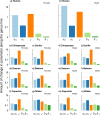The long lives of primates and the 'invariant rate of ageing' hypothesis
- PMID: 34135334
- PMCID: PMC8209124
- DOI: 10.1038/s41467-021-23894-3
The long lives of primates and the 'invariant rate of ageing' hypothesis
Abstract
Is it possible to slow the rate of ageing, or do biological constraints limit its plasticity? We test the 'invariant rate of ageing' hypothesis, which posits that the rate of ageing is relatively fixed within species, with a collection of 39 human and nonhuman primate datasets across seven genera. We first recapitulate, in nonhuman primates, the highly regular relationship between life expectancy and lifespan equality seen in humans. We next demonstrate that variation in the rate of ageing within genera is orders of magnitude smaller than variation in pre-adult and age-independent mortality. Finally, we demonstrate that changes in the rate of ageing, but not other mortality parameters, produce striking, species-atypical changes in mortality patterns. Our results support the invariant rate of ageing hypothesis, implying biological constraints on how much the human rate of ageing can be slowed.
Conflict of interest statement
The authors declare no competing interests.
Figures



References
Publication types
MeSH terms
Associated data
Grants and funding
LinkOut - more resources
Full Text Sources
Other Literature Sources
Medical

